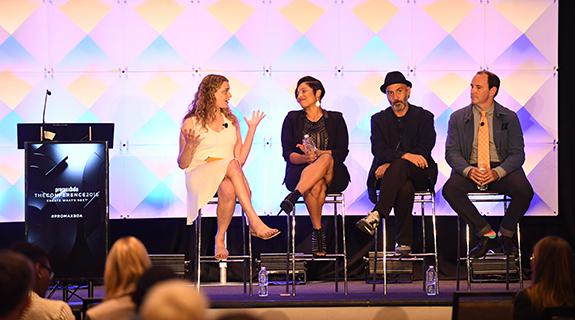Updated Wednesday, June 15, 10 p.m. ET
It started when Target moved away from blue and pink is aisles.
Then Beyonce turned black.
Lori Hall, SVP, marketing and creative Services, TV One; Dan Mannix, president and CEO of Leaddog Marketing Group; and Cristian Jofre, international creative director, Viceland, explored diversity in television during the session “Preparing for Identity Revolution: How New Perspectives on Race, Gender, and Sexuality Are Shaping Content” at PromaxBDA: The Conference 2016.
“I think it’s being portrayed in the media today better than it has has in the past, but we’re not there yet,” Hall said.
While there’s more representation of African Americans on TV, many series need to better at showing stories that reflect individual experiences, and tap into varied spectra that capture the full experience of being African American, and other minorities, she said.
Mannix agrees.
“Just because someone is certain color, race or age, doesn’t mean everybody thinks the same,” he said. “Everyone has their own stories and will look at it through the lens of their own experience.”
Jofre pointed out that bringing more diversity to television needs to start with the hiring process, and Hall elaborated, saying there also needs to be work culture where people feel like they can voice their opinion if there’s a marketing idea they think will be offensive.
“It’s imperative of every single person in this room, every single person in this industry, to speak up,” she said.
While more can certainly be done, Jofre highlighted shows that are pushing the boundaries, like the docuseries Gaycation on Viceland in which Oscar-nominated actress Ellen Page and her friend Ian Daniel travel the world to learn more about the LGBTQ experience.
“She’s a strong character,” said Jofre. “Before for everything related to diversity we used to do 30-second promos, and now we have a whole show.”
Yet there are still conversations that need to happen.
Do you want to explain Caitlyn Jenner to your 6-year-old?” Hall asked. “I don’t know. Do you want to explain what happened in Orlando?”
They also discussed a recent ad where Seth Rogen and Amy Schumer toast same-sex marriage for Bud Light.
They commended the commercial for taking a stand, but also pointed out that it only aired in New York and Los Angeles with the understanding it may not resonate with viewers in different parts of the country who may not be raising their glasses to a gay wedding.
“From a dollars-and-cents standpoint would not be the most strategic thing,” Mannix said. “Whether it’s the right thing to do is an important subject to be talking about, but it’s not going to benefit them from the bottom line.”
It’s a balancing act, and brands need to approach controversial subjects in a way they can be proud of.
“As long as a brand can stand behind why they’re doing it and it feels authentic, then it resonates with people regardless of color,” Mannix said.
ABC’s black-ish, for instance, raises important conversations around race with a sense of humor.
Fox’s Empire is another diverse show, but its success is also indicative of strong content.
“They craft storylines and characters that appeal to so many different archetypes,” Hall said.
With a rising Generation Z that’s more ethnically blended and exposed to diversity at an early age, the future of diversity in TV marketing is also going to evolve.
“I’m so thrilled,” Hall said, “about the opportunities and possibilities.”
[Cube image courtesy of Image Group LA.]
Tags:













































__twocolumncontent.jpg)











